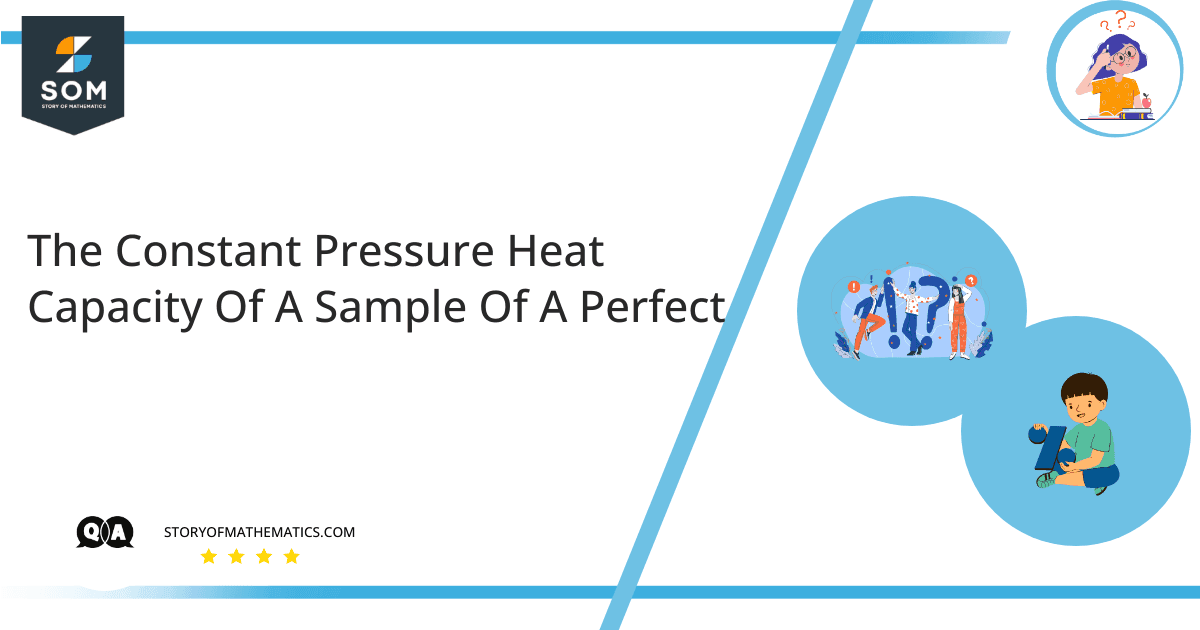
– The pressure is constant.
– The volume is constant.
The main objective of this question is to find the work and change in enthalpy at constant pressure and constant volume.
This question uses the concept of enthalpy and the first law of thermodynamics. Enthalpy is a measure of thermodynamics that corresponds to a system’s overall heat capacity. It is equivalent to the system’s internal energy plus the product of the system’s volume and pressure while for thermodynamic processes. The very first law of thermodynamics is a special case of the energy conservation law.
Expert Answer
A sample’s constant-pressure heat capacity can be calculated using the formula:
\[ \space C_p ( \frac{ J }{ K } ) \space = \space 20.17 \space + \space 0.4001T \]
The given initial temperature is $ 25^{ \circ} C $.
And the given final temperature is $ 100^{ \circ} C $.
a) When the pressure is constant, enthalpy is:
\[ \space q \space = \space \Delta H \]
\[ \space = \space \int_{298 K}^{ 373 K} C_pdT \]
By putting values, we get:
\[ \space = \space \int_{298 K}^{ 373 K} (20.17 \space + \space 0.4001T)dT \]
By simplifying, we get:
\[ \space = \space 1512.75 \space + \space 10065 \]
\[ \space = \space 11.5 \space \times \space 10^3 \space J \]
\[ \space = \space 11.5 kJ \]
Now:
\[ \space w \space = \space – \space pdV \]
\[ \space = \space – \space nRdT \]
By putting the values, we get:
\[ \space = \space – \space 0.623 \space \times \space 10^3 \space J \]
\[ \space = \space – \space 0.62kJ \]
Now for $ \Delta U $, we know from the first law of thermodynamics.
\[ \space \Delta U \space = \space q \space + \space w \]
\[ \space = \space 11.5kJ \space + \space 0.62kJ \]
\[ \space = \space 10.88kJ \]
b) Now when the volume is constant. A sample’s constant-pressure heat capacity can be calculated using the formula:
\[ \space C_p ( \frac{ J }{ K } ) \space = \space 20.17 \space + \space 0.4001T \]
Thus:
\[ \space = \space 20 .17 \space + \space 0.4001T \space – \space 8.314 \]
\[ \space = \space 11.86 \space + \space 0.4001T \]
Now, heat is:
\[ \space q \space = space \Delta U \space = \space \int_{298 K}^{ 373 K} C_vdT \]
By putting the values and simplifying, we get:
\[ \space = \space 2.83 \space \times \space 10^4 \]
Now:
\[ \space q \space = \space \Delta H \space = \space 2.83 \space \times \space 10^4J \space = \space 28.3 kJ \]
And:
\[ \space \Delta U = \space q \space + \space w \]
\[ \space = \space 28.3 kJ \space – \space 1.45 kJ \]
\[ \space = \space 26.83 kJ \]
Numerical Answer
When the pressure is constant:
\[ \space q \space = \space 11.5kJ \]
\[ \space \Delta H \space = \space 11.5kJ \]
\[ \space w \space = \space – \space 0.62 kJ \]
\[ \space \Delta U \space = \space 10.88kJ \]
When the volume is constant:
\[ \space q \space = \space 28.3kJ \]
\[ \space \Delta H \space = \space 26.8kJ \]
\[ \space w \space = \space – \space 1.45 kJ \]
\[ \space \Delta U \space = \space 26.8kJ \]
Example
In the above question, if the temperature is raised from $ 3o $ degree to $ 100 $ degree. Find the $ q $ at constant pressure.
A sample’s constant-pressure heat capacity can be calculated using the formula:
\[ \space C_p ( \frac{ J }{ K } ) \space = \space 20.17 \space + \space 0.4001T \]
The given initial temperature is $ 30^{ \circ} C $.
And the given final temperature is $ 100^{ \circ} C $.
When the pressure is constant, enthalpy is:
\[ \space q \space = \space \Delta H \]
\[ \space = \space \int_{303 K}^{ 373 K} C_pdT \]
By putting values, we get:
\[ \space = \space \int_{303 K}^{ 373 K} (20.17 \space + \space 0.4001T)dT \]
By simplifying, we get:
\[ \space = \space 10875.9J \]
